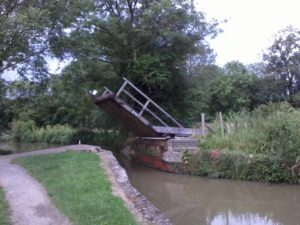I fired up the engine, attached the tiller arm, and untied the bow rope at six o’clock, then, with my British Waterways key in hand, I strolled the few hundred yards up the tow path to the first obstacle: one of the manual lift bridges that make solo boating on the South Oxford Canal a challenge.
BW has recently altered most of these bridges so that they can only be opened with a key — and you can’t get your key back until you pull the bridge closed.
I put my key in the lock and lifted the bridge without much difficulty. After a few bounces it sat up reassuringly (the one on the other side of me has an alarming tendancy to drift back down), and I jogged back to Pangolin. The bow had drifted gently out; I untied the stern line, hopped on board, and set off.

Lift Bridge open and ready
As the boat reached the bridge it began to rain heavily, again. I tied up on the other side of the bridge and went back to retrieve my key. I managed this bridge several times on my own last year, but this summer’s extreme wet has left the bridge so heavy that it was impossible for me to lower it. I hung from chain with no effect and had to wait until a passing bicyclist came to my rescue and closed it for me — and even he found it difficult.
Just after the lift bridge a sharp left leads to a lock and Duke’s Cut — a channel about half a mile long constructed by the Duke of Marlborough, and opened in 1789 linking, for the first time, the Oxford Canal with the River Thames. The Duke owned a paper mill by the river, and I suppose his cut meant the paper could be more easily transported to its main customer, Oxford University Press. Later, when the mill was no longer water-powered narrowboats brought coal along the Cut to run the mill.
At the lock I saw red boards were up, meaning the river authority advises “users of all boats not to navigate because the strong flows make it difficult and dangerous”.
Too late! I was already committed. I had booked my slot at the boat yard for bottom blacking and new anodes months ago and Pangolin was due to come vout of the water first thing in the morning.
The rain was coming down in torrents as I worked the lock and entered Duke’s Cut. I rounded the first few bends when a passing boat, headed in the opposite direction, shouted that the river was rising and I shouldn’t try to navigate the Thames.
“Just as far as the boat yard,” I called cheerfully, and carried on.
Duke’s Cut joins the Thames just above King’s Lock, and straight ahead is the large DANGER sign of the weir. As I turned the boat upstream I immediately felt the current hurtling me towards the weir. Pushing the throttle down hard, I swung the tiller around and felt the boat pull slowly away from the weir. My instinct around trouble is to slow down; I have had to learn that on a boat it is sometimes better to speed up.
The strong current meant that even at nearly full throttle the journey to the next lock (just before the boatyard) took an hour. When I was safely tied up in the lock moorings I called Ratty who was waiting at the local pub to help lock me through. Unlike on the canal, Thames locks are manned during the day, but by the time I arrived, the lock keeper had long since finished his shift.
In a few moments Ratty and Bones (a blog friend I have oftened waved to but never actually met before) appeared. Ratty assured Bones I wouldn’t need both gates; he opened a single gate, and I drove in, Bones admiring the power of my engine to keep the boat straight in the strong current (while I was mightily relieved not to mess up in front of an audience).
Ratty rode with me as Bones closed the lock. I negotiated the arches of Swinford Bridge without mishap, but watching the current swirl around the bridge, I was already worrying about getting my boat back. Going upstream under the arches was one thing — hurtling down through the arches and round a bend towards a row of moored fibreglass boats looked like quite another — and Ratty agreed that he had had about the scariest narrowboat ride in his life going downstream through the same bridge the week before.
I said I was also worried about the weir at King’s Lock and Ratty replied that that was why Bones was still on the Thames — she wanted to be back on the canal but doesn’t dare make the turn.
Meanwhile, my plan was, once the boat was tied up at the boatyard, and the keys dropped off, to bicycle back along the towpath the five or so miles to Oxford, but I had badly mistimed my arrival, and it was nearly dark when I set off on the bike, and both Bones and Ratty looked sceptical, warning me how waterlogged the path was.
My wheels sank so far into the mud that I kept having to get off and drag the bike, while water poured over the tops of my trainers. I made it as far as the lock, more walking than riding, where I abandoned the towpath for the road. It was the long way round, but once I reached the A road into Oxford I knew there was a bicycle path all the way.
The road route took me over the bridge I had boated under. Though it is a public road,a private owner was by a 1767 Act of Parliament given the right to collect tolls (now 5p for cars; more for lorries and buses). The bridge causes huge traffic jams and, though it sounds like it would hardly be worth collecting the toll, apparently it brings in (income tax free, also by that old Act of Parliament) revenues of a couple of hundred thousand pounds a year. The bridge was sold a few years ago for more than £1.5 million.
Bikes are exempt from the toll, and I sped though, along the dark road and around several roundabouts until I reached the main road that comes into Oxford from the west and joined the bike path.
By then it was pitch dark, and as the bike path into Oxford faces oncoming traffic, I was blinded by headlights for much of the ride. Nevertheless, I almost made it unscathed, but only a quarter of a mile or so out of the city I was blinded where the path had an abrupt edge, and hitting the edge I was thrown off. I suffered nothing worse than torn rain trousers and a skinned knee so, glad that I had left my little dog in Oxford instead of carrying her in the bike basket as I sometimes do, I brushed myself off and continued my ride.
At nearly eleven o’clock I wheeled my bike into my ex-husband’s house in Summertown, Oxford. He was away, but had kindly offered me a place to stay while the boat was in the yard.
And there I am now stranded, as the wet weather continues relentlessly.






